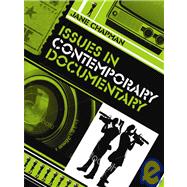
What is included with this book?
| Acknowledgements | p. vii |
| Introduction | p. 1 |
| The question: continuity and change | |
| Contextual issues | |
| Methodology and how to use this book | |
| Chapter summary | |
| Definitions: Issues and Influences | p. 8 |
| Summary | |
| Introduction | |
| Evolution of the genre | |
| Cinema, television and ‘docu-soap’ | |
| Definitions of fiction and non-fiction | |
| Case study: Death of A President (2006) | |
| Genres, categories and uses of documentary | |
| The journalistic documentary | |
| Realism | |
| Arguments about truth | |
| Case study: Loose Change (2005) and Screw Loose Change (2006) | |
| Conclusion | |
| Representation: Problems, Purpose and Perspective | p. 28 |
| Summary | |
| Introduction | |
| Representing history | |
| Ethnography and pioneering democratization of representation | |
| Ethnography and the ‘other’ | |
| Case study: She's a Boy I Knew (2007) | |
| Institutions, minorities and identity politics | |
| Representing collective struggle | |
| Representing trauma, women, children and human rights | |
| Comparative case study: War/Dance (2007), Autism: the Musical (2007) | |
| Conclusion | |
| Objectivity/Subjectivity: Pursuing Truth? | p. 48 |
| Summary | |
| Introduction | |
| From verityé to television current affairs | |
| Objectivity and the journalistic documentary | |
| Institutional influences | |
| Television impartiality and balance | |
| Forms of subjectivity | |
| Case study: Tarnation (2003) | |
| Audiences and activism | |
| Presenting the personal | |
| Subjectivity and the essay form | |
| Activist subjectivity | |
| Case study: Sicko (2007) | |
| Case study: 9/11 Chronicles (2007) | |
| Mash-up, documentary and the Internet | |
| Conclusion | |
| Censorship: Whose World Is It? | p. 72 |
| Summary | |
| Introduction | |
| Circumventing the State | |
| Self-censorship | |
| The self-censorship of the market and funding | |
| Case study: Outfoxed (2004) | |
| Institutional practices | |
| Case study: The War Tapes (2006) | |
| Historical memory and censorship by inertia | |
| Political contexts | |
| Potential audience reception | |
| Conclusion | |
| Authorial Voice: Editorial and Message | p. 93 |
| Summary | |
| Introduction | |
| Uses of documentary and authorial voice | |
| ‘New documentary’ in the 1980s and 1990s | |
| Role of subject matter | |
| Case study: An Inconvenient Truth (2006) | |
| Historical contexts | |
| Direct Cinema and observational films | |
| Case study: Être et Avoir (2002) | |
| Use of interviews | |
| Use of voiceover | |
| Balancing evidence with argument | |
| Comparative case study: Taxi To the Dark Side (2007), No End in Sight (2007) | |
| Using authorial voice to extend a film's debate | |
| Conclusion | |
| Reflexivity: Techniques and Reflection | p. 114 |
| Summary | |
| Introduction | |
| Reflexivity and anthropological films | |
| Comparative case study: Tribe (2007), Amazon (2008), Return of the Tribe (2007) | |
| Vertov and the reflexivity of process | |
| Audience reflexivity | |
| Political challenges and the audience | |
| Reflexivity with deception | |
| Producer reflexivity | |
| Subjective reflexivity and personal autobiographical film | |
| Case study: A Complete History of My Sexual Failures (2008) | |
| Case study: Les Plages d'Agnès (2008) | |
| Conclusion | |
| Audience: A World View or Viewing the World? | p. 134 |
| Summary | |
| Introduction | |
| Research | |
| Counting values on the Net | |
| Perceptions of responsibility | |
| Changing viewing environments | |
| Comparative case study: The Family (1974), The Family (2008) | |
| The ‘contract’ with audience | |
| Genres, activism and engagement | |
| Case study: Battle for Haditha (2007) | |
| Audience identification | |
| Conclusion | |
| Ethics: Shifting Boundaries | p. 156 |
| Summary | |
| Introduction | |
| ‘Consent’: dealing with participants, and payment | |
| Rights | |
| Trust | |
| Balance of power | |
| Case study: A Jihad For Love (2007) | |
| ‘Informed consent’ | |
| ‘Privacy’ and institutions | |
| Case study: Titicut Follies (1967) and informed consent | |
| The problems of intervention and privacy | |
| Voyeurism | |
| A right to know? | |
| Fakery and digital images | |
| Case study: Zeitgeist (2007) | |
| Codes and limitations on journalistic values | |
| Conclusion | |
| Conclusion | p. 178 |
| Notes | p. 182 |
| Bibliography | p. 186 |
| Filmography | p. 196 |
| Index | p. 201 |
| Table of Contents provided by Ingram. All Rights Reserved. |
The New copy of this book will include any supplemental materials advertised. Please check the title of the book to determine if it should include any access cards, study guides, lab manuals, CDs, etc.
The Used, Rental and eBook copies of this book are not guaranteed to include any supplemental materials. Typically, only the book itself is included. This is true even if the title states it includes any access cards, study guides, lab manuals, CDs, etc.